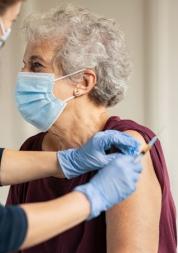COVID-19 Insight Report – Lockdown 2: What relatives of Greenwich elderly care home residents are telling us

The feedback in this briefing is based on information shared in December 2020 by 8 relatives of residents in 6 of the 11 Greenwich elderly care homes.
General feedback
All relatives praised care home staff and thanked them for all their hard work and continuous effort to keep residents safe and well.
Who can/can’t visit
Many felt that decision-making regarding visits is inconsistent. For example, why in some care homes, hairdressers are able to enter care homes, but relatives can not and the huge impact this has on both families and residents.
Share your views
It only takes a minute to tell us about your experience of health and social care. We use your views to raise concerns with the people running NHS and social care services to make care better.
Frequency of visits
Experience varies amongst the relatives we spoke to. Some care homes have no limits to the number of times in a week relative can visit but other care homes have a limited number of slots. We were told that in one home, it is 4 slots a day – 2 in the morning and 2 in the afternoon - making it difficult for residents with larger families and for those who want to visit more often. Where visits are allocated on a first come, first served basis – appointments can fill up quickly. It is not clear if slots are allocated equitably and if all residents with willing visitors are able to get an appointment.
Arranging to visit
In some care homes the system works well. Relatives ring and book a visit with any member of staff working in the part of the home their relative lives in. In other homes, booking arrangements are more complex with only one designated member of staff responsible for arranging visits, and they are not always available. Moreover, in one care home the system has changed several times over the past few months, making it difficult to know who/how to arrange a visit.
Visiting residents
All but one relative we spoke to told us they have been able to visit their loved one since the summer. Visits take place outside, in the garden. In some care homes, relatives sit outside, and residents sit in the conservatory or outdoor pod. In other care homes both relative and resident sit outside. Relatives note a lack of privacy as in some care homes, more than one outdoor visit takes place at the same time.
Relatives are concerned about garden visits in cold weather and feel conflicted. They want to continue to visit but (in homes where residents sit outside for visits) can see their loved one is visibly cold. They are worried that visits will need to stop because of cold weather. Relatives want to visit loved ones inside care homes.
In all instances, visitors are required to keep their face masks on for the duration of the visit. Relatives told us the use of face masks during visits brings additional challenges:
- Residents (especially those with dementia), are often unable to identify them, causing distress and confusion.
- Face masks make it difficult for residents with hearing impairments to hear what is being said to them or to lip-read. Relatives reported having to shout.
Because of the need to wear face masks at physical visits, whilst relatives would much rather have in-person face-to-face interaction without face masks, if this is not possible, we were told that communication with residents via Skype/face-time is a better alternative. However, relatives report poor connectivity issues in some care homes making digital calls difficult or impossible.
To find a solution, in some instances, care home staff allow residents to use administrative offices (where connectivity is better) to face-time family and friends.
COVID-19 tests for visitors
Care homes permitting visits require relatives to take a COVID-19 test days in advance of their visit. This is difficult for families living at some distance from the home. One relative shared their experience of a four hour round trip to receive the test. Having access to rapid COVID-19 tests would reduce the burden on relatives who live at some distance from the home.
Communication
Communication between care homes and relatives is mixed. Some relatives are pleased with the level of communication from care homes, noting regular newsletters and virtual relative meetings. These homes respond to queries quickly, are open to suggestions and feedback, keep them updated about their loved one, and make it easy for relatives to contact them.
However, not all care homes meet this standard.
Some relatives report little or no communication from care homes. Suggestions on improving support for relatives, and increasing communication between relatives and residents, are ignored. More worryingly, these relatives feel it is very difficult to raise concerns.
Resident wellbeing
Relatives of care home residents with dementia have specific concerns. Many feel care home residents are well looked after physically but their psychological and emotional needs have not been met.
Three of the relatives we spoke to told us that their loved ones entered care homes less than a year ago (at the time of this report). One resident went straight into self-isolation for the first two weeks, causing them much distress and confusion. Another relative feels their loved one has significantly deteriorated since being in the care home. They are considering taking them out of the care home, should another lockdown arise. In comparison, only one of the three relatives told us they felt very supported and reassured by the care given by the home.
End of life care
Nearly all the relatives we spoke to have been involved in end-of-life care and Do Not Attempt Resuscitation (DNAR) discussions. These have been in place prior to COVID and no additional discussion have taken place since then.
The future
Whilst a very recent development, all relatives told us that they had begun to think about whether their loved one should receive the COVID vaccine. Mainly, relatives wanted to know how soon the vaccine would be rolled out to in care homes. The longer-term impact of the COVID-19 pandemic on care homes is a worry for relatives.
Relatives want to know when they will be able to visit relatives inside the home again and what can be done in the meantime to improve communication between care homes and relatives.
Downloads
If you require any of the information in this article in a different language or format, please contact us on 020 8301 8340 or email info@healthwatchgreenwich.co.uk
